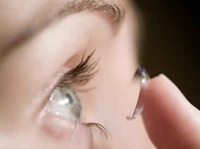








A contact lens, or simply contact, is a thin lens placed directly on the surface of the eye. Contact lenses are considered medical devices and can be worn to correct vision, or for cosmetic or therapeutic reasons.In 2004, it was estimated that 125 million people (2%) use contact lenses worldwide, including 28 to 38 million in the United States.In 2010, worldwide contact lens market was estimated at $6.1 billion, while the U.S. soft lens market is estimated at $2.1 billion.Some have estimated that the global market will reach $11.7 billion by 2015.As of 2010, the average age of contact lens wearers globally was 31 years old and two thirds of wearers were female.
In 1888, the German ophthalmologist Adolf Gaston Eugen Fick constructed and fitted the first successful contact lens.While working in Zürich, he described fabricating afocal scleral contact shells, which rested on the less sensitive rim of tissue around the cornea, and experimentally fitting them: initially on rabbits, then on himself, and lastly on a small group of volunteers. These lenses were made from heavy blown glass and were 18–21 mm in diameter. Fick filled the empty space between cornea/callosity and glass with a dextrose solution. He published his work, "Contactbrille", in the journal Archiv für Augenheilkunde in March 1888.
Fick's lens was large, unwieldy, and could only be worn for a couple of hours at a time. August Müller in Kiel, Germany, corrected his own severe myopia with a more convenient glass-blown scleral contact lens of his own manufacture in 1888.
Also in 1887, Louis J. Girard invented a similar scleral form of contact lens.Glass-blown scleral lenses remained the only form of contact lens until the 1930s when polymethyl methacrylate (PMMA or Perspex/Plexiglas) was developed, allowing plastic scleral lenses to be manufactured for the first time. In 1936, optometrist William Feinbloom introduced plastic lenses, making them lighter and more convenient.These lenses were a combination of glass and plastic. in 1940, German optomestrist Heinrich Wöhlk produced plastic lenses, based on experiments performed during the 1930s.
In 1949, the first "corneal" lenses were developed.These were much smaller than the original scleral lenses, as they sat only on the cornea rather than across all of the visible ocular surface, and could be worn up to sixteen hours per day. PMMA corneal lenses became the first contact lenses to have mass appeal through the 1960s, as lens designs became more sophisticated with improving manufacturing (lathe) technology.
Current research
A large segment of current contact lens research is directed towards the treatment and prevention of conditions resulting from contact lens contamination and colonization by foreign organisms. It is generally accepted by clinicians that the most significant complication of contact lens wear is microbial keratitis and that the most predominant microbial pathogen is Pseudomonas aeruginosa.Other organisms are also major causative factors in bacterial keratitis associated with contact lens wear, although their prevalence varies across different locations. These include both the Staphylococcus species (aureus and epidermidis) and the Streptococcus species, among others.Microbial keratitis is a serious focal point of current research due to its potentially devastating effect on the eye, including severe vision loss.
One specific research topic of interest is how microbes such as Pseudomonas aeruginosa invade the eye and cause infection. Although the pathogenesis of microbial keratitis is not well understood, many different factors have been investigated. One group of researchers showed that corneal hypoxia exacerbated Pseudomonas binding to the corneal epithelium, internalization of the microbes, and induction of the inflammatory response.One way to alleviate hypoxia is to increase the amount of oxygen transmitted to the cornea. Although silicone-hydrogel lenses almost eliminate hypoxia in patients due to their very high levels of oxygen transmissibility,they also seem to provide a more efficient platform for bacterial contamination and corneal infiltration than other conventional hydrogel soft contact lenses. A recent study showed that Pseudomonas aeruginosa and Staphylococcus epidermis adhere much more strongly to unworn silicone hydrogel contact lenses than conventional hydrogel contact lenses and that adhesion of Pseudomonas aeruginosa was 20 times stronger than adhesion of Staphylococcus epidermidis.This might help to explain one reason why Pseudomonas infections are the most predominant. However, another study conducted with worn and unworn silicone hydrogel and conventional hydrogel contact lenses showed that worn silicone hydrogel contact lenses were less prone to Staphylococcus epidermidis colonization than conventional hydrogel contact lenses.